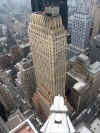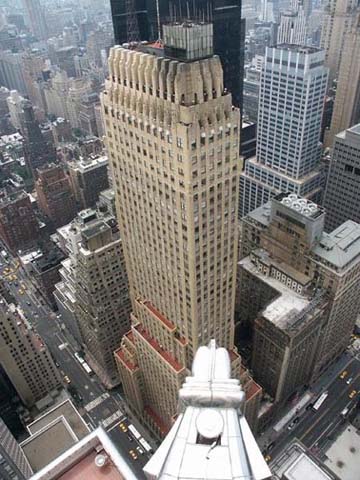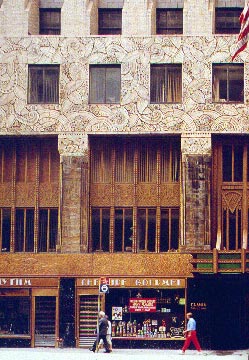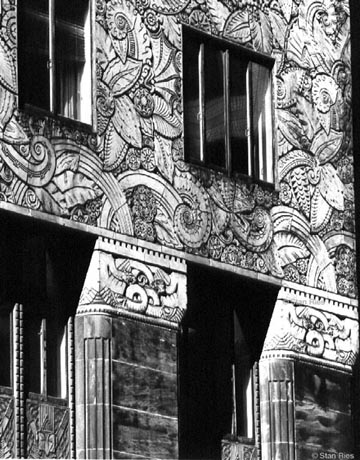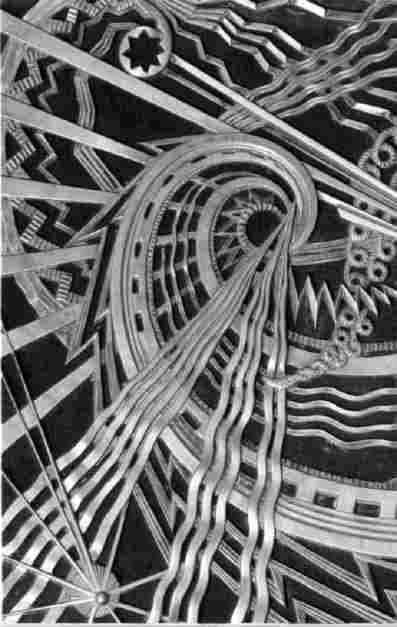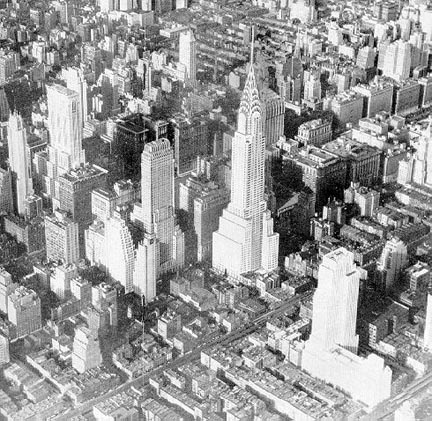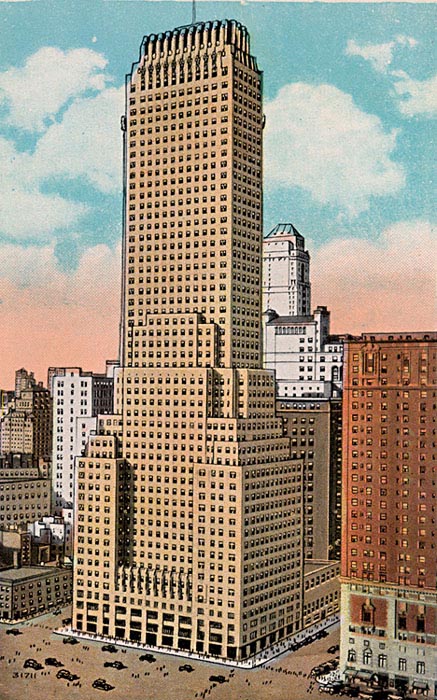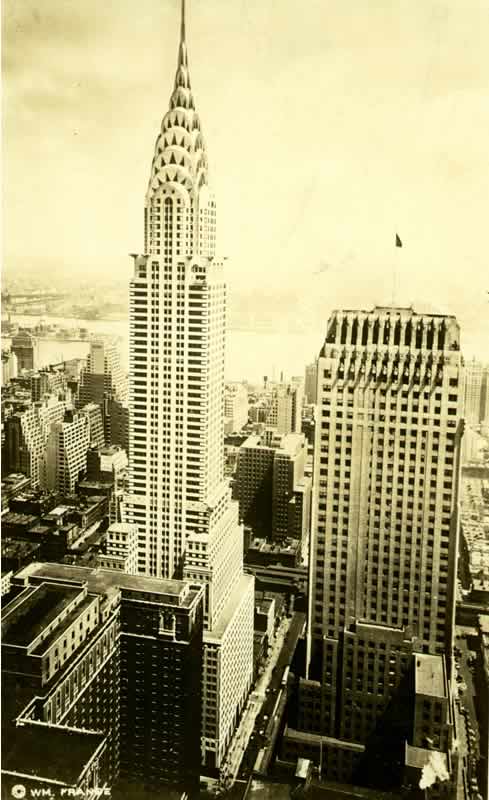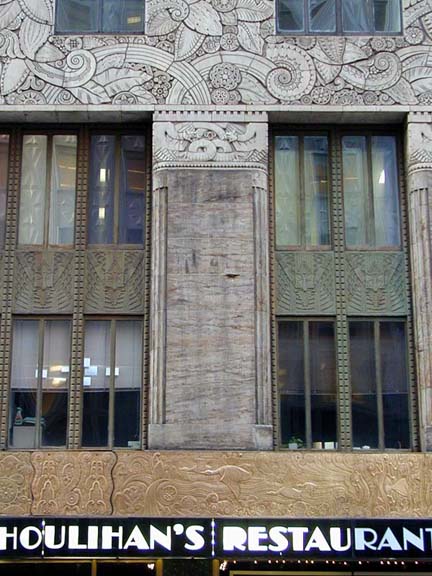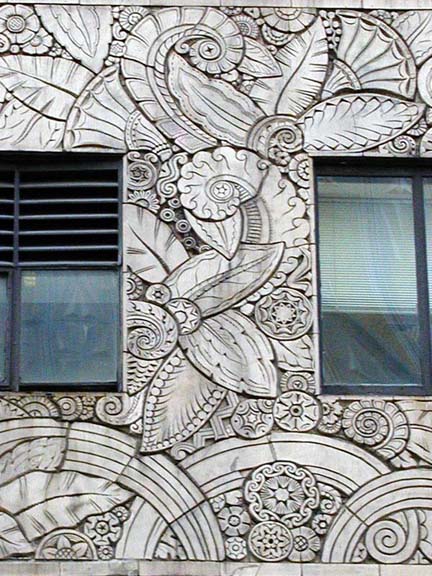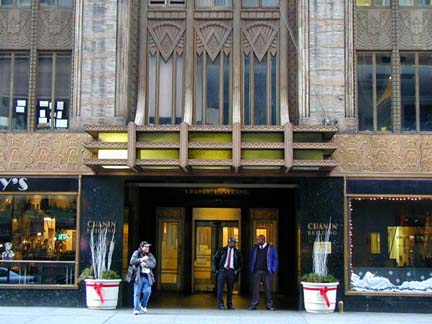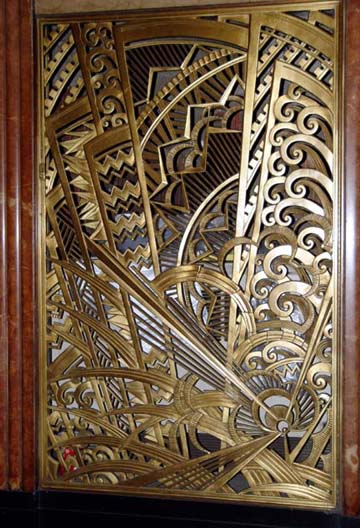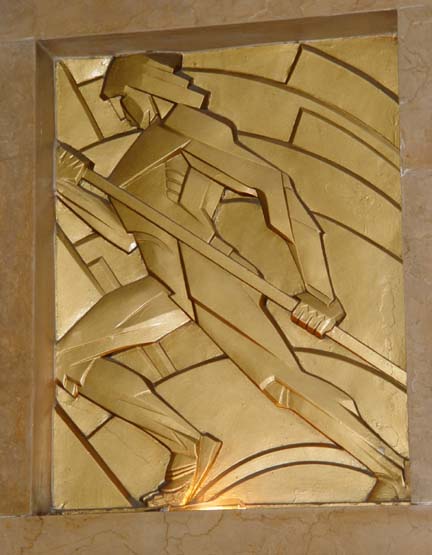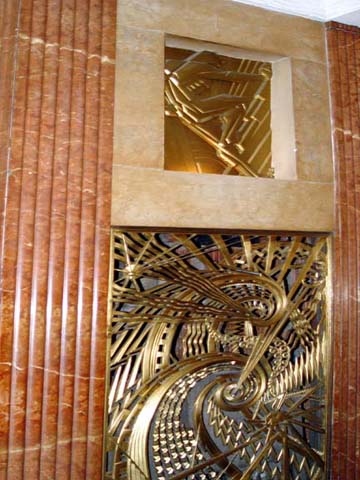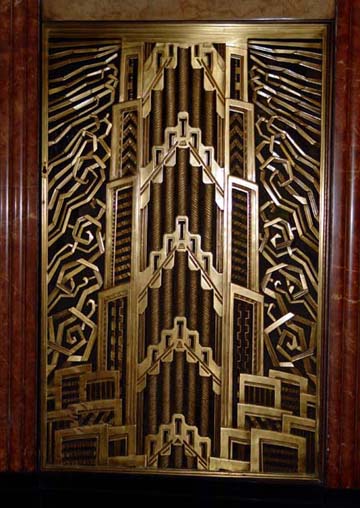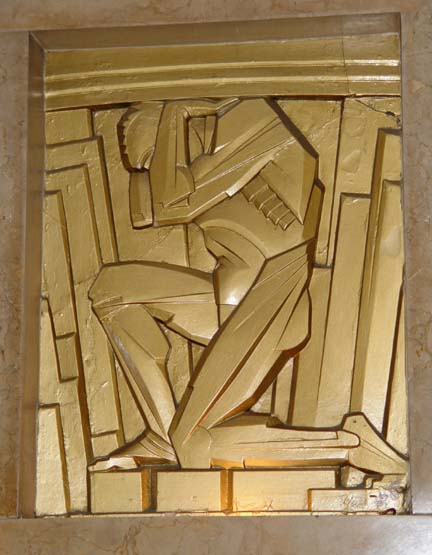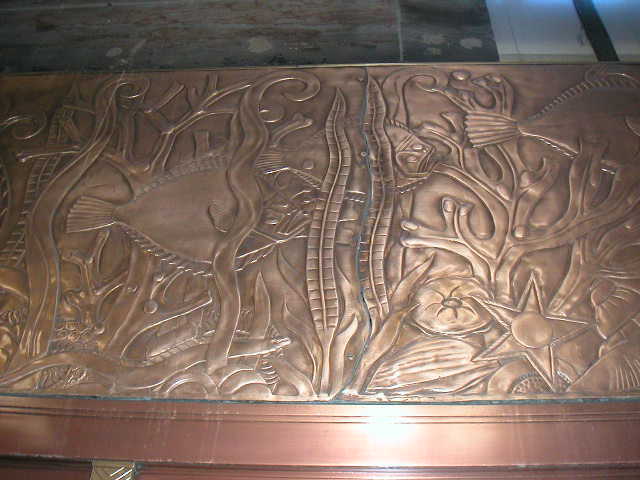|
Built in 1927-1929 for Irwin S. Chanin, one
of the most notable developers in the city.
The 56-storey, 207.5 m tall Art Deco building is typically set back from
the limestone base. The top of the buff-brick tower sports elegant
buttressing decor that is enhanced by illumination at night. The corners
of the unornamented tower have protruding fins. At the lower end of the
building, bas-reliefs of terra-cotta depicting animals and leaf themes
run the whole length of lower facade.
The lobby was designed by Jacques Delamarre to celebrate the "self-made"
success of Irwin Chanin. The floor and screens are made of gilded
bronze, with modernist decor motifs of workers and transports by the
sculptor René Chambellan. Also the elevator doors and mailboxes are
elaborately decorated.
There was a private cinema theater on the 50th floor, as well as a viewing
roof, neither of which is accessible anymore. Also a bus depot with a
rotating turntable on the ground floor has been converted to other uses.
The Chanin Building is located at 122 east
42nd street and was completed in 1928, reaching a whopping height of 680
feet. This 56 story towers blunt buttressed crown became a symbol for
New York's crushing modernist drive. The buff-brick, limestone, and
terra-cotta tower is a fascinating synthesis of skyscraper styles. The
giant limestone buttresses at the base and crown are a conscience
reference to the skyscrapers stylistic origins in the gothic world. Its
giant 680 foot shaft rises uninterrupted for 22 stories above a series
od shallow setbacks. The thinness of this slab viewed from uptown or
downtown, creates a classic Art Deco setback silhouette. This is a two
in one solution which was copied also by the McGraw Hill Building, and
Rockefeller Center. The crowns reverse is lit at night so that the
buttresses are thrown into shadow, and the recesses are illuminated.
This building, built as leaseable office space, the building presents
itself as a high point of creation. A bronze frieze located at street
level depicts it as the sea and the tower as land. Another frieze on the
4th floor of the facade proclaims itself as a building of the 2oth
century.
One of the first great examples of a
building that uses the French-inspired art-deco motifs is the Chanin
Building, located on the southwest corner of Lexington Avenue and
Forty-second Street. The architect, Irwin Chanin, had built Garment
Center loft buildings and a number of other buildings in New York. He
planned this one for his own offices and as a speculative venture—that
is, his private offices were on the top floor while the rest of the
building was open office space. Construction began in 1927.
Chanin trained at Cooper Union as an architect, but in 1927 he was not yet
registered. He eventually became a registered architect, but that year
he worked with the architectural firm of Sloan and Robertson. The firm
had worked on the Fred French Building and was involved in many
different office buildings in New York. Chanin worked with Sloan and
Robertson to come up with a spectacular design (which is very closely
modeled on Eliel Saarinen's plan for the Chicago Tribune Building) that
features a massive, horizontal base, soaring setbacks, strong verticals,
and buttresses. The building soars above the corner of Forty-second
Street and Lexington Avenue, right down the block from Grand Central
Terminal. And the light bounces off its façade. So this building was
highly visible.
Besides being a spectacular ornament on the New York skyline, the building
is filled with French-inspired ornamental detail. Chanin had visited
Paris in 1925 and toured the Exposition Internationale des Arts
Décoratifs et Industriels Modernes. He was so inspired by it that when
he came back, he almost immediately started using these French-inspired
forms. A building like the Chanin was designed not only to attract your
attention from a distance but also to be both enjoyable and even
educational on the ground floor. And it was designed so that on the
lower stories it would attract not only pedestrians but also potential
tenants. The detail on this building is some of the most exquisite
art-deco ornament ever created in New York. There is a band of stylized
terra-cotta with curving and angular leaflike forms not unlike those on
Ferrobrandt's Cheney Silk Company doors. There is a frieze over the
storefronts that was meant both to entertain and to educate. It depicts
the theory of evolution. The frieze starts with amoebae and then, as you
move along, the amoebae become jellyfish, the jellyfish become fish, the
fish become geese, and yet there it stops. At that point, the theory
became too controversial.
There are also dynamic storefronts covered with zigzag patterns. This
design has come to be probably the most popular ornamental detail that
people are familiar with from art-deco buildings. But one of the
interesting things about the use of this pattern on such buildings is
that the zigzag almost never appears by itself. The angular, geometric,
mechanical zigzag is almost always overlaid with ornate, curving flower
petals. This combination of the mechanical and the natural overlaying
each other creates a very complex iconography on these buildings.
LOBBIES
The lobbies of this building are among the most interesting in the city.
They tell a story about New York as the city of opportunity. And the
city of opportunity was Irwin Chanin's life. Chanin was a poor immigrant
who was able to find success in New York because it offered him abundant
opportunity. He became one of its great developers and believed there
was opportunity for all in both intellectual and physical pursuits. With
its two main lobbies, one dedicated to each type of pursuit, the Chanin
articulates these beliefs. Both lobbies also house a stylized figure
that represents some aspect of either the intellectual or the physical
life. And below each figure is a bronze grille that represents this same
force in an abstracted way. So you see a figure striding forward atop
its abstraction below. This is probably the first use of abstract
ornament in an American building. Chanin designed it with the assistance
of the artist René Chambellan, who specialized in architectural
sculpture and was very popular in 1920s New York. The plaster figures
have this kind of stylized, almost hyper masculine form and they are
somewhat cubist in detail. It was a style that was very popular in the
1920s and the early 1930s. You can see the impact of European modernism
on these sculptures. And so in each one of these lobbies, there are four
of these groupings—four physical pursuits and four intellectual
pursuits.
Then you walk into the main lobby and find beautiful elevator doors that
use the same geese motif used outside. You could take one of the
elevators all the way up to the top floor, to Chanin's office. But
before you entered the office, you had to pass through a pair of bronze
gates that were every bit as much a part of the building's story. The
gates represented the greatness of the city, with its art and commerce
and its tremendous dynamism. You notice their gears, which signify the
industrial prominence of a great city like New York. And, at the top, in
the center, you see a violin that splits in half, indicating the
cultural life of the city. Then you spot these very dynamic bolts that
shoot through, indicating the city's dynamism. Or perhaps you might
interpret them as representing New York, the communication empire. Note,
though, that none of this would have been possible without a great deal
of money and so these gates rest on piles of gold coins. So he designed
these gates to sum up for you what the city was all about, before you
entered his private offices, which were also elaborately designed with
art-deco details.
Andrew Dolkart |
